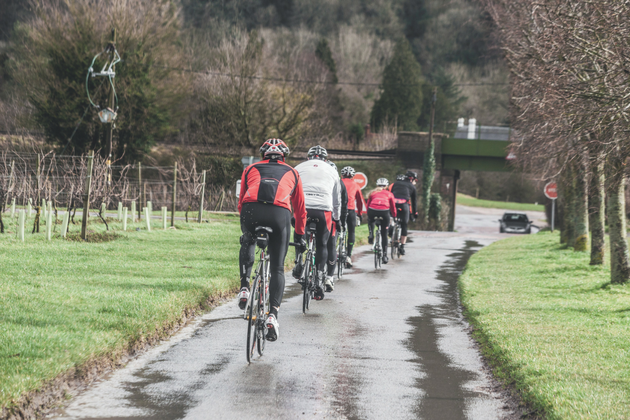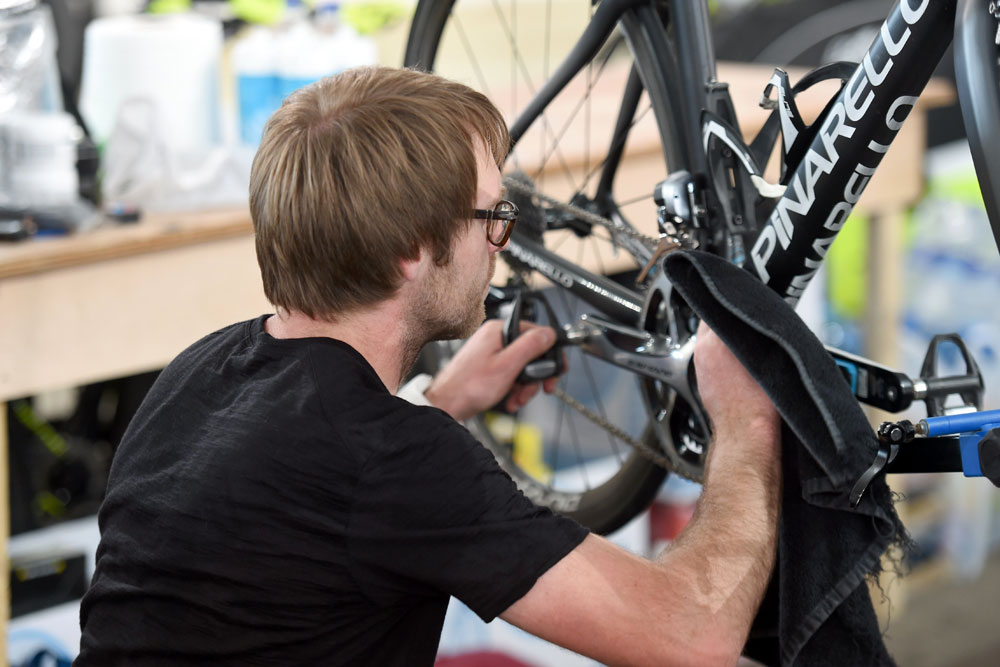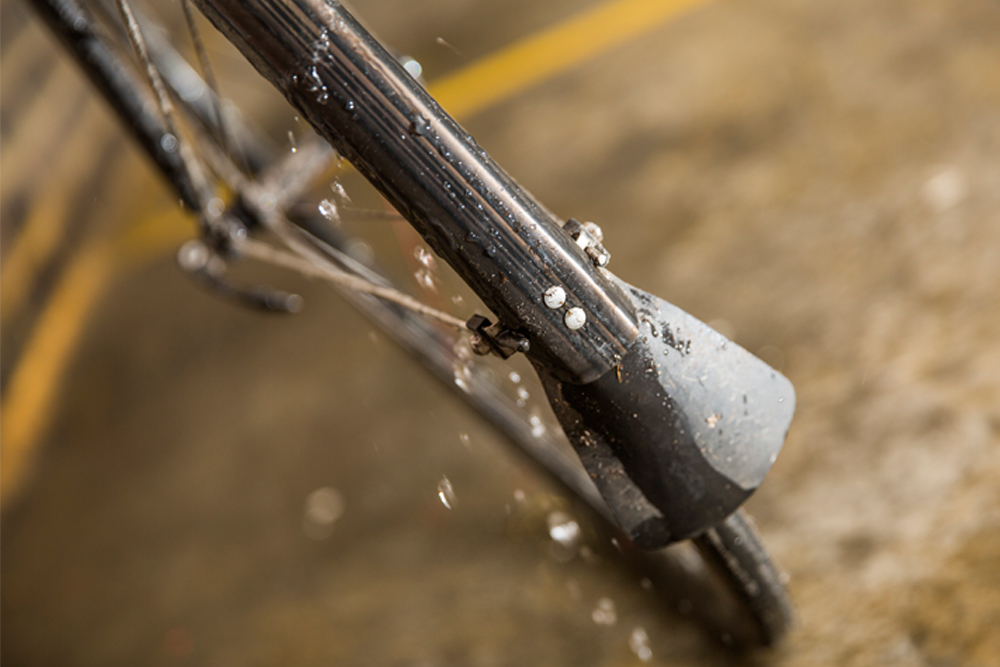Seven essential tips to get your bike ready for winter (video)
This video and the accompanying tips, below, will help you get your bike ready for winter and keep you cycling until spring finally makes an appearance

Months of riding in wet conditions can do some serious damage to your bike. To help make riding throughout the winter more pleasurable, whether you’re lucky enough to have a dedicated winter steed or are going to soldier through on your one main machine, here are seven ways to protect your bike from the bad weather:
1. Clean it
Seeing as your bike is likely to be covered in muck after only a few miles in really bad conditions, it might seem a bit counter-intuitive to spend an hour or two making sure it's beautifully clean.
But making sure your bike is clean will not only make it easier to see any mechanical defects, but will also (hopefully) get you into a cleaning routine for the rest of the winter.
>>> Eight simple ways to make your bike faster for free
The best thing to do is to give your bike a quick wipe down after every ride; nothing too thorough, just taking five minutes to get rid of the worst of the mud.
Then every week or two take a little longer to give the drivetrain a proper clean. It might seem like a faff, especially after a long ride in the cold and rain, but if you can keep this going then you'll save a lot of money in the long term.
2. Service it

Once your bike is clean, it's time to give it a good check over to make sure everything is running smoothly. This is especially important if you're using a bike that's been tucked up in the garage since April.
This would mean inspecting the bearings, checking the chain and cassette for signs of wear, and doing the same for the brake and gear cables. Anything that doesn't look like it's up to the job should be replaced as soon as possible.
All of these tasks are easy enough to do at home, but if you're not feeling confident then there's always the local bike shop.
Once you're happy that everything is running smoothly, don't forget to lube the chain using a thicker lube than usual. This will last longer in rubbish conditions than lighter lubes, keeping your drivetrain running smoothly.
3. Fit mudguards

If you want to do a single thing to make your winter riding more pleasant for yourself (not to mention your bike and riding mates), then fit a pair of mudguards.
If you've got a dedicated winter bike then the likelihood it will probably have mudguard eyelets, allowing you to fit heavy duty mudguards that will offer good coverage, but if not then there are plenty of clip on mudguards out there. Just make sure you've got enough tyre clearance.
If you don't want to make enemies on the club run then it's also worth fitting a rear mudflap. This is easy to bodge together at home.
All you have to do is drill a hole in the bottom of your mudguard then attach an extra strip of material, essentially extending the mudguard downwards therefore stopping the rider behind you from getting covered in mud and whatever else might be on the roads.
4. Fit training wheels

If you've invested in an expensive pair of deep section wheels, winter definitely isn't the time to get your money's worth out of them.
Not only will they get extremely dirty, but the bearings are likely to wear out more quickly and if they've got a carbon braking surface then the might not stop as well in the wet.
If you haven't got any other cheaper wheels hanging around, then a good pair of training wheels is a worthwhile investment.
The most important thing to look for is a wheelset with a high spoke count to make sure they stand up to the battering of British roads, and maybe one with a wider rim, meaning you can get a greater volume of air inside your tyres.
5. Fit winter tyres
While cheaper wheels might be a good choice for winter, cheap tyres most definitely aren't. Riding in the cold and wet can be unpleasant at the best of times, but if you also have to spend 20 minutes at the side of the road fixing a puncture, then a ride can be properly ruined.
>>> Winter road bike tyres: a buyer’s guide
To avoid this, it's really worthwhile investing in a dedicated pair of winter tyres, which will offer extra layers of puncture protection.
For added comfort it's also worth going for wider tyres, either 25mm or 28mm, which can be run at a lower pressure in order to improve comfort and offer better grip in wet conditions.
6. Double wrap your handlebar tape
One final way to improve the comfort of your winter riding is to double wrap your bar tape. Although this is a tip usually reserved for the pros on the cobbles of Paris-Roubaix, anyone will notice the extra cushioning that it will offer on rough roads.
If you can, try and find a gel tape that will offer an extra layer of padding.
7. Get some good lights
An essential addition to any winter bike is a good pair of lights. Personally I like to keep two rear lights on my bike throughout the darker months: one main one, and another back up one just in case the other runs out of battery.
This is even the case when riding during the day, as you may well need a rear light even in the middle of the day during gloomy weather or when you'll be hard to spot against the low sun.
>>> Best front bike lights for under £100
As for the front light, this isn't quite as crucial to have attached at all times, but it's still not a bad thing to have on your bars once the days start getting darker around 3 o'clock.
And of course if you're using your bike to commute, then both front and rear lights are absolutely essential, and worth spending a bit of money on if you're riding beyond the glow of street lights.

Thank you for reading 20 articles this month* Join now for unlimited access
Enjoy your first month for just £1 / $1 / €1
*Read 5 free articles per month without a subscription

Join now for unlimited access
Try first month for just £1 / $1 / €1
Get The Leadout Newsletter
The latest race content, interviews, features, reviews and expert buying guides, direct to your inbox!
Henry Robertshaw began his time at Cycling Weekly working with the tech team, writing reviews, buying guides and appearing in videos advising on how to dress for the seasons. He later moved over to the news team, where his work focused on the professional peloton as well as legislation and provision for cycling. He's since moved his career in a new direction, with a role at the Department for Environment, Food and Rural Affairs.
-
 'This is the marriage venue, no?': how one rider ran the whole gamut of hallucinations in a single race
'This is the marriage venue, no?': how one rider ran the whole gamut of hallucinations in a single raceKabir Rachure's first RAAM was a crazy experience in more ways than one, he tells Cycling Weekly's Going Long podcast
By James Shrubsall
-
 Full Tour of Britain Women route announced, taking place from North Yorkshire to Glasgow
Full Tour of Britain Women route announced, taking place from North Yorkshire to GlasgowBritish Cycling's Women's WorldTour four-stage race will take place in northern England and Scotland
By Tom Thewlis